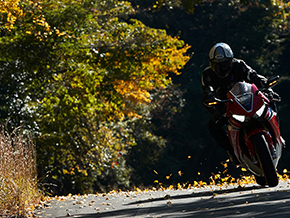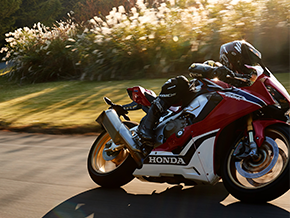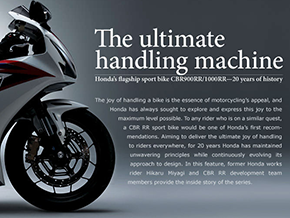Motorcycles Technology
CBR1000RR - Engineers Talk Part 2
The Future of the Super Sports Bike, Seen Through the CBR1000RR

Satoru Okoshi, Control Design
Honda Selectable Torque Control (HSTC) suppresses rear wheel slip in turns and while accelerating, by minutely controlling engine torque based on throttle opening and roll angle. By suppressing rear wheel slip, the rider can accelerate as imagined, with confidence, and enjoy riding.
HSTC does not mean the bike goes as fast as possible once the throttle is opened, but helps riders when they go beyond their limits. The rider comes first.
Honda Selectable Torque Control (HSTC)
Rear wheel slip and front wheel lift (wheelie) are detected from front and rear wheel speed sensors and an inertial measurement unit (IMU), and are suppressed by operating the throttle valve to control torque.

Satoru Okoshi, Control Design

Chiaki Yamamoto, Electronics and Hardware Designer
Chiaki Yamamoto, Electronics and Hardware Designer
In addition to control design, we also took a lot of care in operating feel.
With throttle-by-wire, or quick shifters which allow shifting gears without clutch operations, we introduce a component between the rider and the bike that did not exist before. We were determined not to allow it to reduce the direct operation feel that has been nurtured for so many CBR-RR generations.
Miyagi
Looking back at quick shifters used in racing bikes, they were not smooth to use at all. In racing, the result is all that matters, but on a production bike, operation feel needs to be pleasant.
Yamamoto
That’s right. We made springs and friction generating devices to recreate the feel of throttle cable operation, and tested different versions to find the right resistance, and we experimented with the stroke sensor’s internal structure to find a solid touch so the rider would not know a sensor is embedded.
We didn’t want riders to feel they were operating electronic components, but know they were riding a bike, a machine. I’m confident that the new CBR-RR feels like a “real” bike, even for seasoned riders.

Quick Shifter
The quick shifter is a system that frees the rider from clutch and throttle operations needed to shift up and down the gears. A stroke sensor on the shift rod converts shift pedal input into electric signals. This data with the ECU’s bike speed, acceleration / deceleration and gear position data control the timing to halt fuel injection, throttle valve position and ignition timing. Gear shifts without clutch operation are made possible by removing drive load from the gears.
Electronically-controlled Suspension to Provide the Perfect Ride
for As Many Riders as Possible
Miyagi
The SP’s suspension is now electronically controlled. The suspension’s damping characteristics are actively controlled according to riding conditions such as bike speed and bank angle.
Was it a difficult task to perfect the suspension, given that moving, turning and stopping are all correlated in the system?
Korogi
We knew development would be difficult, considering the number of devices the system controlled. Our goal, however, was performance allowing the rider and bike to act as one, and to be enjoyable, in as many situations as possible. To express the fun and pleasure of controlling the bike purely according to the rider’s will. To this end, in addition to reducing weight to reduce inertial moment, we were all for electronically controlled suspension that would actively control bike attitude.
We felt that the new generation CBR1000RR was the perfect timing.
Miyagi
The CBR-RR’s attractiveness built up over the years, with a new electronic control system. It does seem to be the right timing for a new device.
Korogi
The system’s hardware has a lot in common with other models, but we used the latest generation control technology we codeveloped with ÖHLINS, the suspension manufacturer. A major feature is OBTi. This allows the rider to easily adjust suspension characteristics for deceleration, turning and acceleration, using the dashboard and handle bar switches. We put most of our effort into developing suspension mode presets coordinating with the various control devices.
Iwaya
I am involved in bike racing, so I know it’s really difficult to fully understand how to change the suspension to get a particular characteristic. You’re out on the track, pit, adjust using tools, repeat it all over again, and gradually gain an understanding. I think all bike racers have spent their days finding the right settings to suit their styles. With the CBR1000RR, you don’t need tools. The settings can be changed by the flip of a switch. The freedom in riding suddenly expands.
Yamamoto
That’s right. We made springs and friction generating devices to recreate the feel of throttle cable operation, and tested different versions to find the right resistance, and we experimented with the stroke sensor’s internal structure to find a solid touch so the rider would not know a sensor is embedded.
We didn’t want riders to feel they were operating electronic components, but know they were riding a bike, a machine. I’m confident that the new CBR-RR feels like a “real” bike, even for seasoned riders.

ÖHLINS Smart EC System
Codeveloped with the suspension manufacturer ÖHLINS. The suspension control unit receives bike data from each control unit to continuously assess riding conditions, and adjusts front and rear suspension damping characteristics accordingly.
OBTi…Objective Based Tuning Interface.
OBTi is an Öhlins developed suspension tuning interface. The main functionality is to provide an interface where the rider can adjust the semi-active damping system to his preference. The tuning is done in terms of intuitive vehicle dynamical characteristics, such as the amount of support from braking to acceleration. The system uses built in knowledge about the event based control strategies to optimize the vehicle’s behavior in accordance to the tuning objectives set by the rider. Equipped on CBR1000RR SP/SP2.
Miyagi
Setting up suspension according to the rider’s style has a strict process, and requires knowhow. It’s a pretty high hurdle to enjoy bike riding.
There are probably many riders who change all sorts of settings according to their style, only to end up with a bike that is hard to ride. I think this system which allows settings to be changed easily is a godsend for many riders.
Korogi
We went with ÖHLINS engineers, who are at the forefront of racing technologies, to test tracks at Honda’s test facilities in Japan, to find the right settings for riding fast on a race track, for enjoying winding roads, for riding confidently on city streets and rough road conditions. We went to the tracks and roads in Europe to further tune the settings to cover every imaginable riding scene. We spared no effort in perfecting the specifications while considering the various situations a rider would encounter.
Yamamoto
Public roads, in some ways, are more difficult than a race track: A bad strip of road, followed by a sudden rainstorm, for example. That’s why we were adamant in being able to switch modes while riding, and we’re confident that we built a character that is enjoyable under any, and I mean any, condition for the CBR-RR which has its roots on the public road.
CBR1000RR - Engineers Talk



